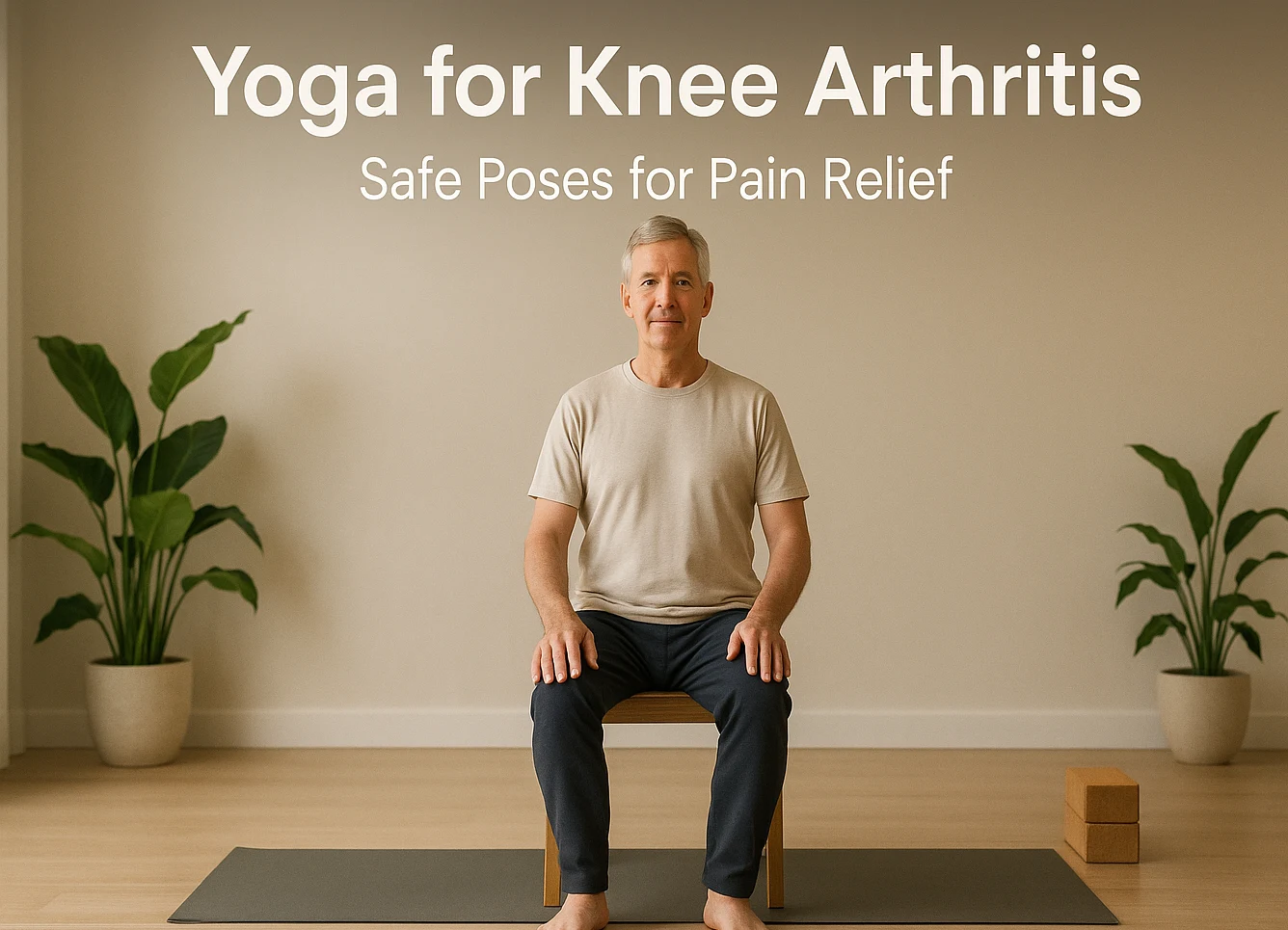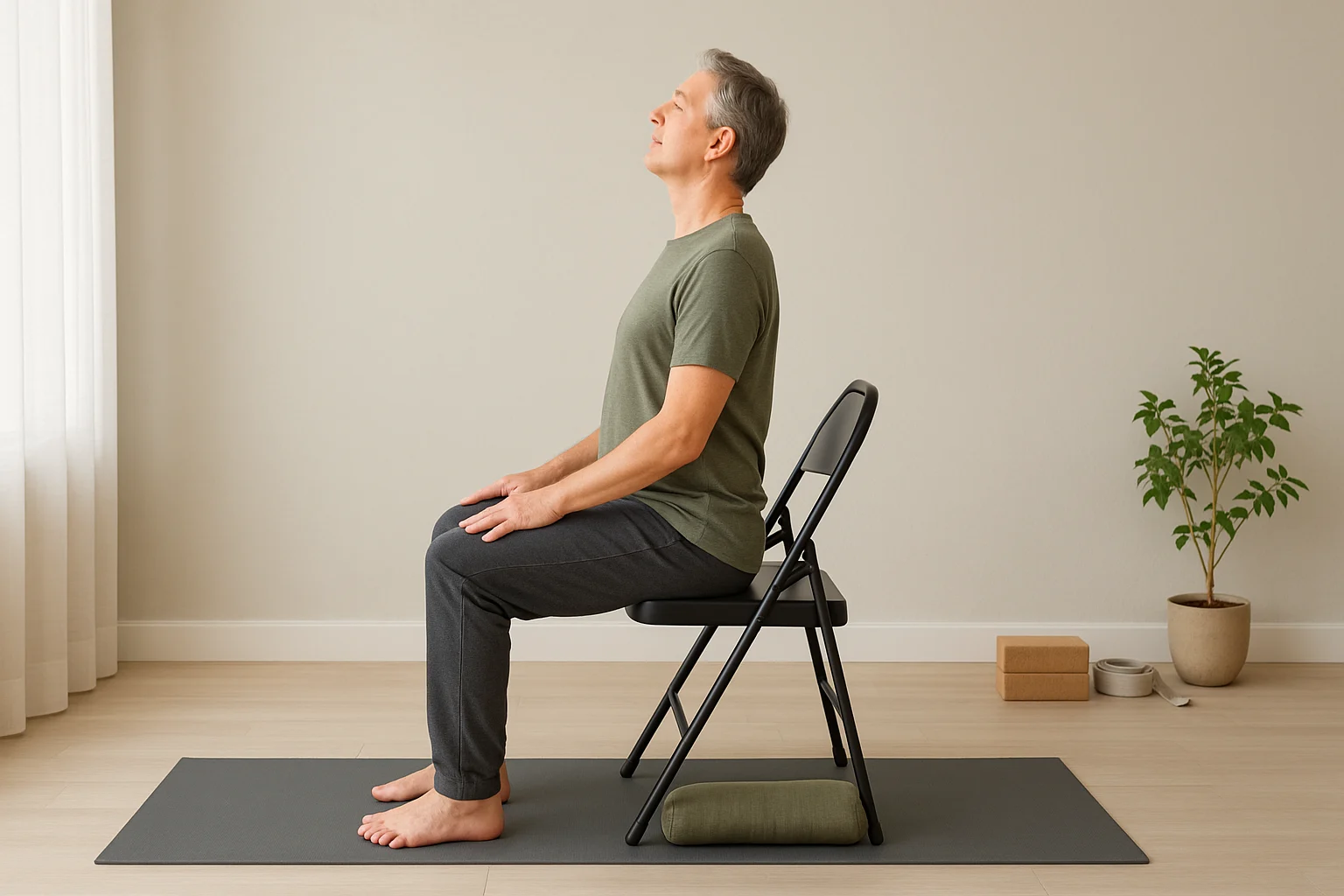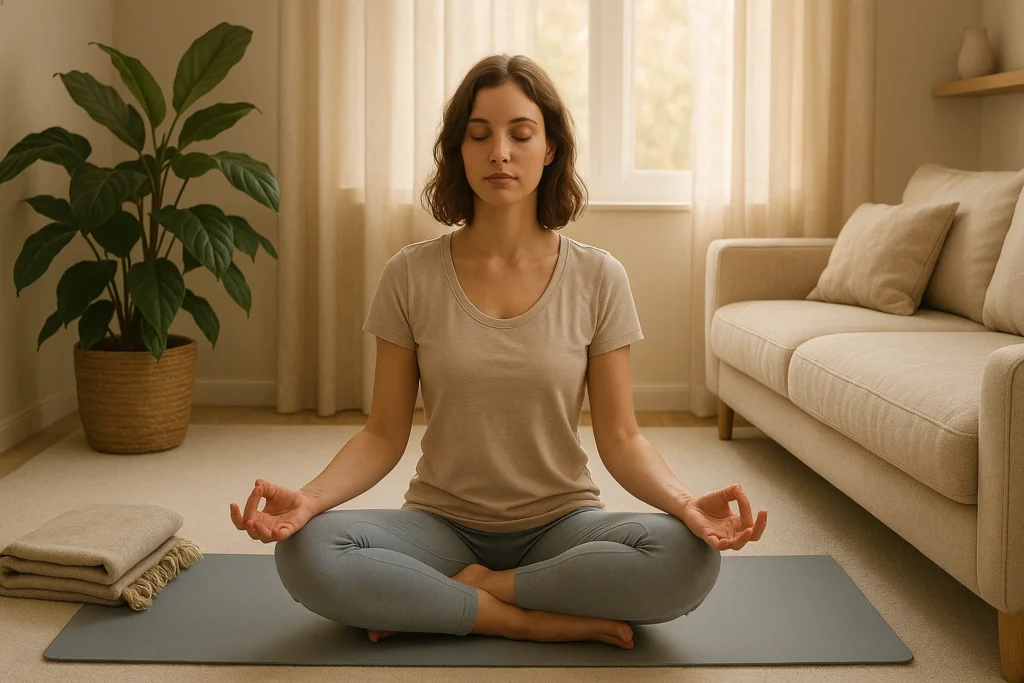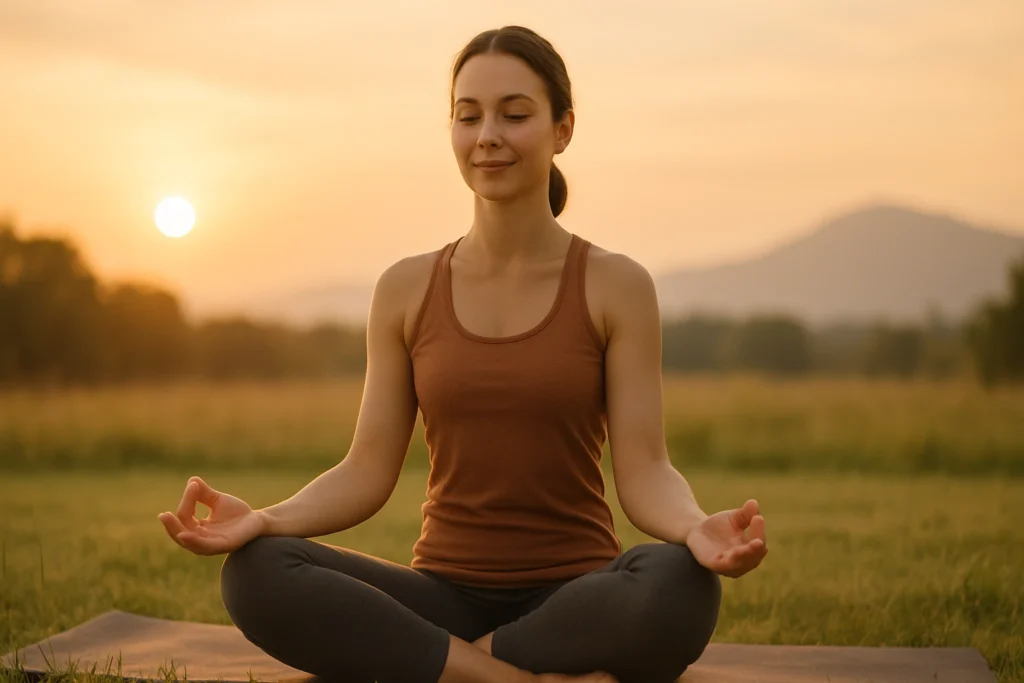
Struggling with knee arthritis pain? If you’ve been searching for yoga knee arthritis relief, you’re not alone—gentle routines can make everyday moves feel doable again. For many of us it’s the little moments: a twinge on the stairs, stiffness getting up from a chair. Moving a sore joint can feel intimidating, so the goal isn’t to push through pain but to move smarter. Gentle, controlled yoga for knee arthritis may be very helpful. With a bit more strength around your knees, a touch of flexibility, and a calmer mind, daily life can start to feel easier. This guide shares safe, practical ideas—with simple modifications to help you move with ease—as part of our broader guide to yoga specialized health.
Table of Contents
- Why It Helps (Overview)
- Safety Tips for Knees
- Real Relief: A Yoga Success Story
- Gentle, Knee-Friendly Poses
- Pose Cheat Sheet
- Strengthening Exercises (Support)
- 5-Minute Routines
- Mild vs. Severe: What to Try
- Avoiding Strain & Red Flags
- Make It a Habit
- Find Your Best Knee Poses (Quiz)
- Frequently Asked Questions
- Embrace Yoga for Healthier Knees
Yoga Knee Arthritis: Why It Helps
Most knee arthritis is osteoarthritis — the joint’s cushion (cartilage) thins, and the knee can feel stiff, puffy, and sore. Suddenly, simple stuff like getting up from a chair or taking the stairs feels harder. It’s normal to move less when it hurts, but that often weakens the muscles that protect the joint — and the pain–stiffness cycle continues.
For those exploring yoga for knee arthritis, the practice can help break that cycle. Research summarized by the Arthritis Foundation suggests gentle yoga may ease knee pain in osteoarthritis. Here’s why:
- Builds support: Stronger quads, hamstrings, and glutes act like better “shock absorbers” for your knees.
- Loosens up: Slow, controlled ranges of motion help lubricate the joint and ease stiffness.
- Can dial down pain: Regular movement can support synovial fluid movement and may help with pain and stiffness; evidence for pain reduction is mixed.
- Steadier on your feet: Balance work improves stability and confidence.
- Calms the system: Breath and short meditations may help your nervous system cope with chronic pain. Explore more on yoga for stress relief.
“Yoga isn’t just exercise; it’s a way to listen to your body and nurture it with purposeful movement.”
This post has affiliate links. We may earn a commission. Learn more.
Yoga Knee Arthritis: Safety Tips
Before you start, think safety first. Yoga shouldn’t create sharp pain. Check in with your doctor or physical therapist — especially during flares. Here are the essentials:
- Listen to Your Body: Discomfort is okay; sharp pain isn’t. Stop or modify if it hurts.
- Move Slowly: Gentle, mindful movements protect your knees.
- Prioritize Alignment: Correct form trumps deep stretches. Keep joints safe.
- Use Props: Chairs, blocks, blankets, and straps reduce strain and add support. Learn more about essential yoga props.
- Avoid Hyperextension: Keep a micro-bend in your knees during standing poses.
- Warm Up and Cool Down: Start and end with gentle movements.
- Stay Consistent: Short, regular sessions (10-15 minutes daily) beat intense, infrequent ones.
Quick Tip: Always keep a chair nearby for balance or support — it’s like having a trusty friend!

Real Relief: A Yoga Success Story
Meet Robert, 68, a retired teacher. His knees used to cut his dog walks short at the first hill. “Yoga’s for bendy people,” he’d joke—until his PT nudged him toward a chair class. He started with 15-minute sessions: gentle leg lifts, small knee bends, and plenty of breaks—three days a week. After a few weeks the early-morning stiffness let up; a couple of months later he was looping an extra block and even tried a beginner class (chair parked within reach). “Slow and steady wins the race—and saves my knees,” he says. 🐢
Knee Arthritis Yoga Poses
These poses, tailored for knee arthritis, prioritize safety and comfort. Use props and move slowly to protect your joints. Below you’ll find knee arthritis yoga poses to build strength and ease stiffness without strain. Many of these are ideal for chair yoga for seniors.
Yoga for Knee Pain: Standing Options
These build strength and balance with minimal knee stress.
- Mountain Pose (Tadasana) 🏔️: Stand against a wall, feet hip-width, micro-bend in knees. Press shoulders and hips into the wall. Benefits: Enhances posture and leg strength. Modify: Adjust wall distance for comfort.
- Chair Pose (Modified) 🪑: Feet hip-width, hover above a chair as if sitting, chest lifted. Benefits: Strengthens quadriceps and glutes. Modify: Sit briefly for support.
- Warrior II (Modified) 🛡️: Step feet wide, turn right foot out, bend right knee over ankle. Use a chair for balance. Benefits: Opens hips, strengthens legs. Modify: Reduce knee bend.
Floor Poses for Gentle Relief
Add a folded blanket or extra mat for cushion. Choose comfortable, supported positions — avoid any pinch at the knees.
- Supine Hamstring Stretch 🦵: Lie on your back and loop a strap around one foot. Ease the leg toward the ceiling until you feel a gentle stretch. Benefits: Lengthens the hamstrings. Modify: Keep a soft bend in the knee.
- Bridge Pose 🌉: Lie on your back with knees bent; press through your heels to lift your hips. Benefits: Strengthens the glutes and back line. Modify: Squeeze a block between your thighs for support.
- Savasana 😴: Lie back with legs relaxed and a bolster under your knees. Benefits: Helps the nervous system settle. Modify: Adjust the bolster height for comfort.
Quick Tips for Safe Practice
• Keep a chair within reach for balance.
• If you feel sharp pain, back out or stop.
• Slow, controlled reps beat big, fast moves.
Pose Cheat Sheet: Muscles & Knee-Load Tips
| Pose | Target Muscles | Knee-Load Tip |
|---|---|---|
| Seated Leg Lifts | Quadriceps (front of thigh) | Lift to a comfy height — keep knee straight but not locked. |
| Mountain (Tadasana) | Postural muscles, calves, glutes | Stand tall with a micro-bend — weight even through both feet. |
| Chair Pose (Modified) | Quads, glutes, core | Hinge hips back — knees track over (not past) ankles; use a chair. |
| Warrior II (Modified) | Glutes, adductors, quads | Shorten your stance — front knee stacked over ankle, not collapsing inward. |
| Supine Hamstring Stretch | Hamstrings (back of thigh) | Use a strap — keep a soft bend to avoid tugging behind the knee. |
| Bridge Pose | Glutes, hamstrings, back line | Press through heels — squeeze a block to keep knees hip-width. |
Tip: If any pose causes sharp pain, back out, add support, or skip it.
Yoga Knee Arthritis: Strengthening Exercises
Beyond poses, these exercises bolster knee stability.
- Quadriceps Sets: Lie back, towel under knee, press down 5 seconds. Repeat 10-15 times. Why: Stabilizes the kneecap.
- Straight Leg Raises: Lie back, one leg bent, lift other leg 6-12 inches. Repeat 8-10 times. Why: Strengthens quadriceps.
- Clamshells: Lie on side, knees bent, lift top knee. Repeat 10-12 times. Why: Stabilizes hips and knees.
5-Minute Yoga Fixes for Busy Days
No time? Try these quick bits of yoga for knee pain:
- Seated Leg Lifts (2 min): 10 lifts per leg.
- Seated Cat-Cow (2 min): 8 slow cycles.
- Savasana with Bolster (1 min): Relax with knees supported.
These mini-sessions keep your knees moving without overwhelming your schedule.
Yoga for Mild vs. Severe Knee Arthritis
Tailor your practice to your arthritis severity for best results.
| Arthritis Severity | Recommended Poses | Tips |
|---|---|---|
| Mild | Seated Leg Lifts, Chair Pose, Warrior II | Focus on strength; use minimal props. |
| Severe | Seated Cat-Cow, Supine Hamstring Stretch, Savasana | Use chairs and bolsters; avoid deep bends. |
Avoiding Strain and Red Flags
Distinguish between healthy discomfort and harmful pain.
Common Mistakes
- Forcing stretches — go gentle.
- Locking knees — keep a micro-bend.
- Ignoring pain — listen to your body.
- Comparing to others — focus on your progress.
Red Flags
- Sharp pain: Stop immediately.
- Swelling or warmth: Rest, consult a doctor.
- Painful clicking: Be cautious.
- Persistent post-practice pain: Reduce intensity.
“Your yoga practice is a conversation with your body. Listen deeply, respond kindly.”
Integrating Yoga into Your Life
Consistency is key for lasting benefits. Aim for a knee-friendly yoga habit you can repeat on most days.
- Start Small: 10-15 minutes, 3-5 times weekly.
- Find an Instructor: Seek adaptive yoga experts.
- Use Online Classes: Look for chair or gentle yoga.
- Create a Space: A quiet corner encourages practice. Try a no-equipment yoga routine.
- Find Your Perfect Pose: Try the quiz below!
Knee Quiz: Find Your Best Poses
Answer these quick questions to find the best yoga poses for your knee arthritis.
How severe is your knee arthritis?
Do you prefer seated or standing poses?
How much time can you commit daily?
Frequently Asked Questions
Embrace Yoga for Healthier Knees
Knee arthritis doesn’t mean you have to stop moving. A knee-friendly yoga routine can build strength, improve flexibility, and settle the nerves. Start small, use props, and let comfort be your guide. With steady practice, everyday moves may feel easier — and more enjoyable. 🙏


